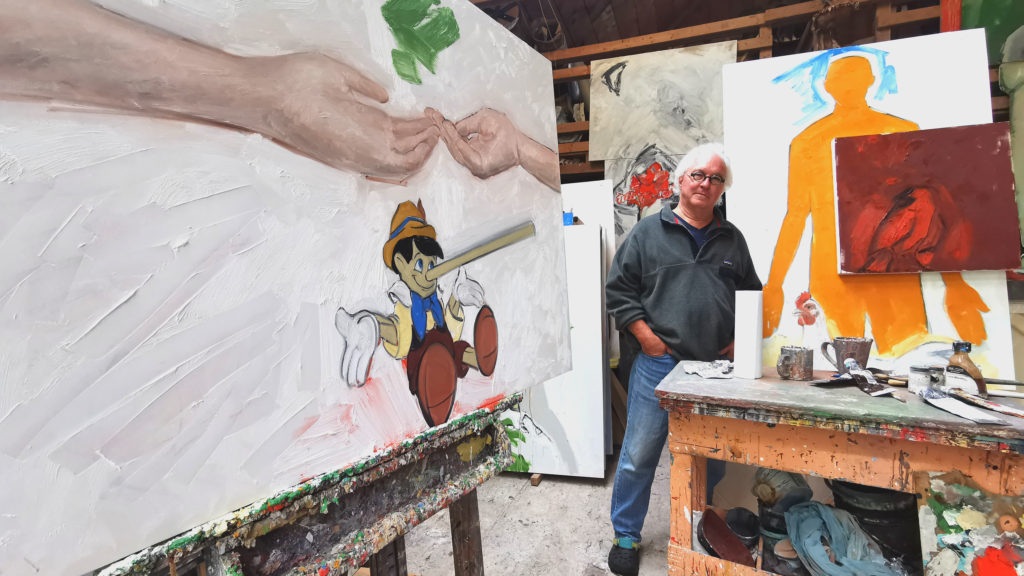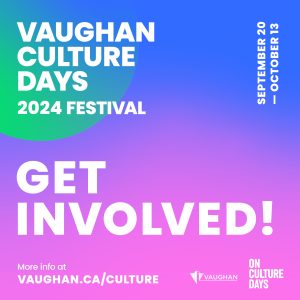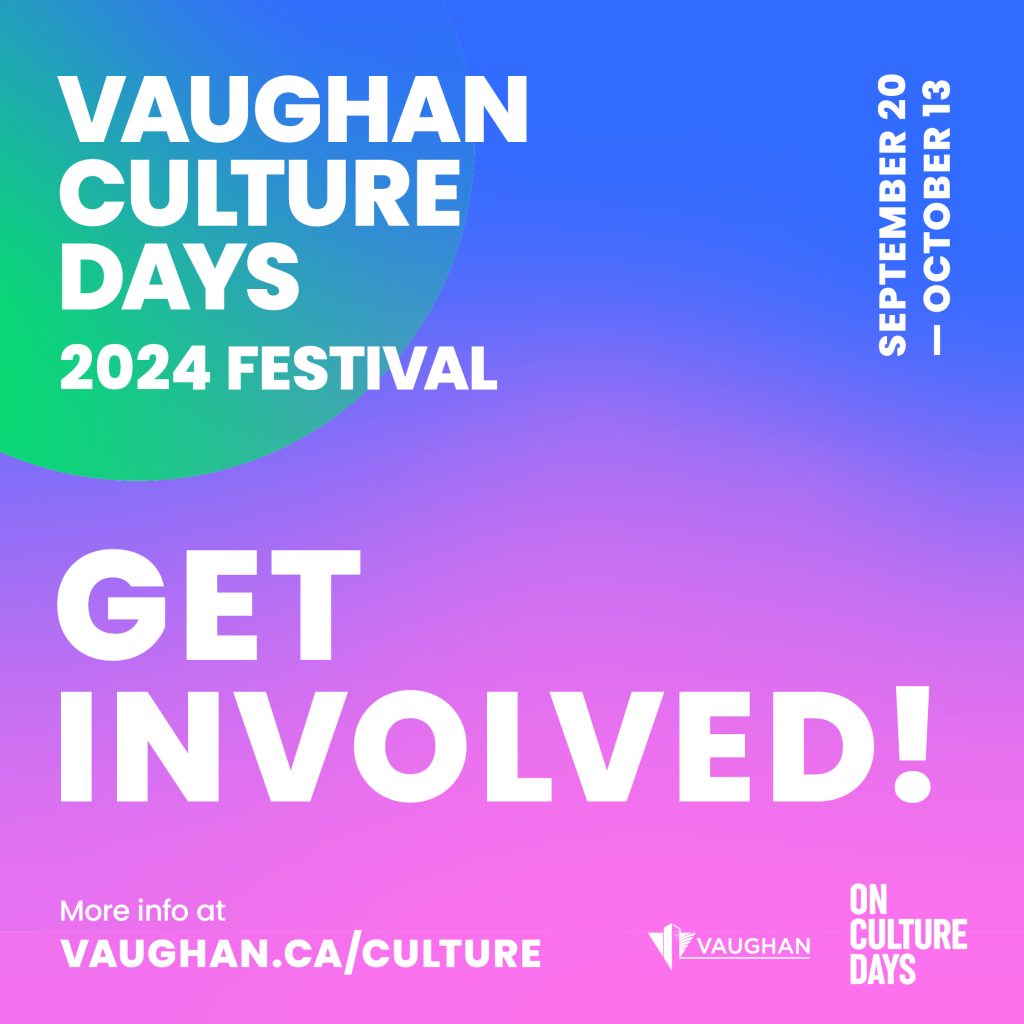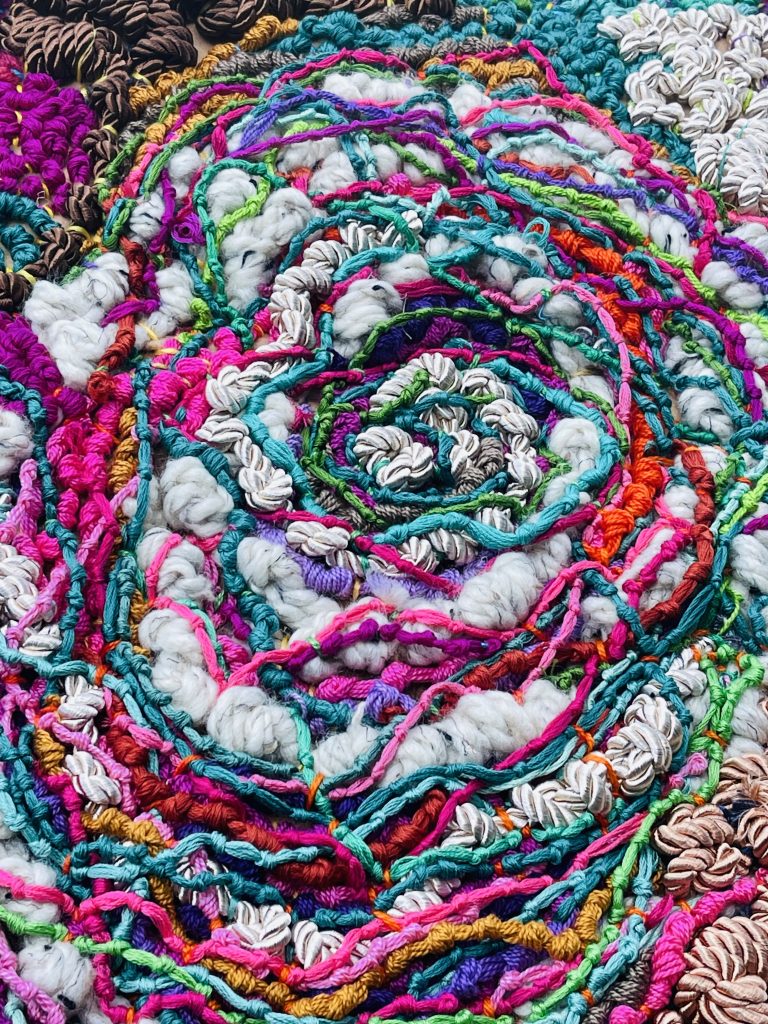Artist Ted Fullerton, above, in his studio where he is working on another chapter of the his dialogue with fellow artist Dazaunggee Shilling. Top photo row, below, from left: Ted to Dazaunggee, Dialogue; Awakening by Fullerton; Quiet Wisdom by Shilling; Dazaunggee to Ted, Dialogue. Second row, from left: Reconcilliation is Within, Sacred Women of the Earth; She Who Knows and My Journey all by Shilling. Third row, from left: Criss Cross at the Crossroads with Indian Red; Phoenix 2022-with ruffled feathers; Human Race and I Can See Clearly now all by Fullerton.
Together in Spirit: Dialogue in Image – Dazaunggee (Paul) Shilling and Ted Fullerton
Oct.1 – Nov.19. Opening Reception: Saturday Oct. 1,1:00-3:00pm
By Wayne Doyle
Artists Ted Fullerton and Dazaunggee (Paul) Shilling befriended each other in the early nineties based on their mutual respect and shared work in the arts. In 2018, the artists met again after years apart. Naturally conversing on
themes such as colonial domination, oppression, aesthetic sensibilities, as well as their personal life experiences, the artists decided to continue their conversation in visual form.
Each artist creates a statement in painting for the other, who responds reciprocally. In Together in Spirit: Dialogue in Image, pairs of paintings meet in truthful conversation and confession with each other. The gallery serves as a safe space for ongoing discussion of honest and perhaps controversial
topics at this current juncture in Canadian History: Original people, spirituality, expropriation of Indigenous land, cultural identity, shame, and language, and more. Through visual creation is an ongoing exploration and declaration for reconciliation.
As an aboriginal man, Dazaunggee (Paul) Shilling feels the need to shed the image that was taught to him as a child – that he was undesirable, shameful, unworthy. As he expresses himself, he heals himself; the inner voice and the
inner eye clear and open for the energy of the image to move through him from “the great house of invention”.
Ted Fullerton is a Canadian artist working in painting, drawing, printmaking, and sculpture. He has achieved awards in all four media. An on-going effort within his practice has been to symbolically confront social issues or situations
where a pictorial language exemplifies an acceptance while also questioning and addressing truths, falsehoods, or generalizations around and of human existence.
This the first of a two-part series where experienceyorkregion.com sits down with both artists to discuss the exhibit. This interview is with Ted Fullerton. The interview with Dazaunggee will appear next week.experienceyorkregion.com: You and Dazaunggee come from completely different backgrounds – one privileged, one not so much. how has this project brought you together – what have you discovered about the self that appears to be consistent across all folks?
Ted Fullerton: Dazaunggee and I met in 1993. As artists we were interested in each others visual expression within our work. Dazaunggee was creating paintings that were expressive in their honesty – as he still does – that naturally sparked my curiosity and further enquiry. Dazaunggee has a quiet and composed demeanour and our conversations touched on colonial injustice, not as a reprimand or rebuke by him but as subtle and informative information that was a reality in his life, not mine. This literally “opened my eyes” to the injustice, cruelty and wrongs of colonization not to mention how “we” were “climatized” to see “the other”. I remember feeling ashamed that I did not have insight into these wrong doings or was I just deaf and blind to them? Why were we not informed/taught these things in our schooling, why was it not a topic within my home? I was not aware of the sixties scoop, residential schools until years afterward, let alone most recently
the unmarked graves. All of this injustice and racism and cultural genocide
Dazaunggee and his people endured yet Dazaunggee’s temperament and resolve was directed to defining a collective understanding that would slowly yet surely allow healing to happen. Dazaunggee speaks that all people have beautiful spirits and it is about lifting of “the blankets” that suppress that beauty within for it to be revealed. I want to believe and I’m optimistic that benevolence will prevail in humanity, however we live in a complex time were ignorance and hate is shouted louder than reason, honesty and truth. We have to speak up when an injustice is seen, heard or expressed.
xyr.com: There’s a book, actually a series of books, called Griffin and Sabine, about an extraordinary correspondence between a pair of friends. The appeal of the book is the reader is a voyeur, reading correspondence that is intended to be private. Is there a similar feeling for viewers of this show – are we voyeurs to a private conversation? Can a viewer look at the show and follow the conversation from beginning to end?
TF: The engagement and experience of art is open, it must be. We/Humanity absorb life and it is only through “the arts” were that experience is represented, given back anew to be engaged with bringing meaning, consideration and a fresh experience to our lives. Design and illustration is different from art. It leads the individual to a particular place or conclusion, that is what makes great design. However from my perspective great art makes you look longer, think critically and ask more questions. That is what I hope will happen with the audience, that they will experience, consider, wonder and contextualize their experience based on their personal and private engagement with the work.xyr.com: Symbolism and colour play a major role in both of your works. However, often times, symbols in one culture do not have the same meaning in another culture or they have a diametrically opposite meaning. Do you worry about explaining this or do you let the viewer distill whatever meaning they want to take from the work?
TF: Meaning is an “understanding” that is established or fixed differently within each individual based on their personal and cultural experience and upbringing. My work is symbolic and those signs and symbols that exist within my work have a particular meaning to me based on my life experience that I hope can be understood by others – I am interested in universalities, images that cross cultural lines and individual experiences. The “understanding” of symbolic references is dependent on “intuitive knowledge” – less on acquired knowledge – which I believe makes them openly accessible to the diversity of individuals. What I find interesting is how symbolic references have polar opposite intentions and this is important to me as I am interested in the reconciliation of opposites as it associates to humanities dualistic nature. I’ll reference colour as an example – red is symbolically interpreted as love and affection but also hate and retribution, blue can be symbolically interpreted as purity and knowledge but also as sadness/depression and disappointment, yellow as enlightenment but also cowardice. I remember once during an artist talk a person coming up to me afterwards and saying, if you did not explain your intent in some of your work I would not of understood what it meant. I asked that person did you have a “feeling” of what the work was trying to express before my explanation of intent and they said “yes”.
xyr.com: Truth and reconciliation is about learning and confronting the past – openly and honestly – and that’s sometimes difficult for people to do. What have you learned about truth and reconciliation throughout this process?
TF: What I have learned is that everyone has the ability to confront prejudice, bigotry and intolerance. Whenever a disparaging, racist or generalization is uttered or expressed, it is important to speak up and denounce or express in a civilized way your disapproval. We all have other personal ways of communicating the realization of truth. As an artist I have been able to express my thoughts on and about Reconciliation visually – as well – I add my voice. As settlers to this land we have committed a crime against humanity based on greed, self interest, power and control. I have to reflect on Dazaunggee’s words that we all have beautiful spirits and we have to lift the blankets off so we can all meet honestly and freely. I have learnt that it is possible, it has to be.xyr.com: What mark or influence has this experience had on your works moving forward?
TF: I am never quite sure why or how the need to express myself visually manifests itself – I just know I need to realize it. However, I have done works that continue to speak to these issues and I assume it will continue. I like to think my work comes from a place of conscience and “belief”.
xyr.com: Do you and Dazaunggee continue to talk and is there a part two in the future?
TF: Yes, Dazaunggee and I continue to talk, discuss and question a breadth of current issues as well as just “yuk it up”. I am blessed that he has called me Brother. In fact, when we first met in 1993 I did a painting based on meeting him also called, Brother – it is in this exhibition. I consider him a very good friend. And, “yes again” – there is a part two that has emerged. I have recently been invited and embarked on another collaborative project with Dazaunggee and two other artists, Xavier Fernandez and Julie Tian, to visually interpret – individually – the Seven Grandparent Teachings – Truth, Love, Humility, Respect, Bravery, Honesty and Wisdom. To explore the way these universal teachings are viewed by the cultures represented by the Anishinaabe medicine wheel (four cultures) and to arrive at a communal vision of “wisdom”. Our personal and cultural visual responses to the seven teachings will hopefully shed some light on “our” truths as well as a collective truth that we all share. They are being planned for exhibition.
Together in Spirit: Dialogue in Image – The Aurora Cultural Centre – Temporary Gallery:
2nd Floor Gallery: Aurora City Hall
100 John West Way, Aurora










